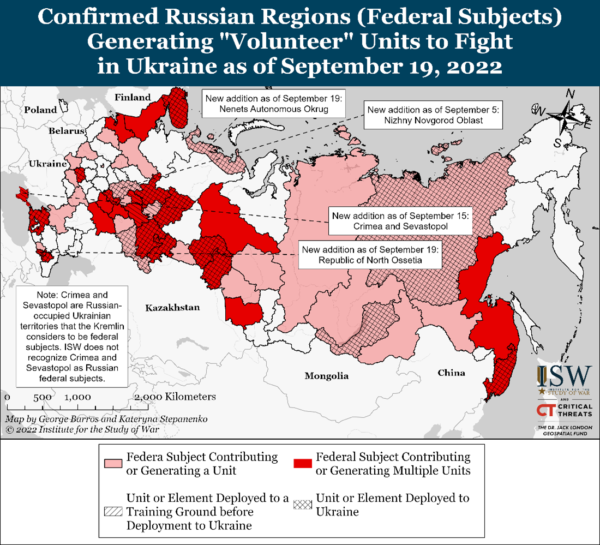Russia’s snap mobilization is unlikely to overcome fundamental structural challenges in recruiting large amounts of Russians for war against Ukraine and will come with high domestic social and political costs, the Institute for Study of War reports.
It is unlikely to add to Russia’s net combat power in 2022 and even beyond because of flaws in Russia’s military personnel and equipment systems:
- Russia lacks reserve force needed for a snap mobilization intended to produce immediate effects on the battlefield;
- Prior to 2008, the Russian and Soviet military approach was to designed to support the full mass mobilization of the entire Russian and Soviet populations for full-scale war, which included universal conscription and a minimum two-year service obligation. But amid the 2008 financial crisis, it cut down the term of mandatory service and ended up with a hybrid model blending conscripts and professional soldiers. Thus, Russia’s reserves are less combat-ready and bureaucratic structures required for mobilization are eroded.
- Moreover, Putin has already conducted at least four attempts at mobilization in the last year, likely draining the pool of available combat-ready (and willing) reservists ahead of the “partial mobilization.” The most recent “partial mobilization” will draw mainly on Russians who have demonstrated that they do not wish to fight by their failures to join “volunteer battalions” or enter the Russian Combat Army Reserve (BARS) program. It may also be drawing on less-qualified involuntary reservists as well, assuming previous involuntary mobilizations pulled in the readiest individuals.
- The ongoing mobilization is likely straining bureaucrats responsible for the efforts, and there appears to be confusion stemming from shared responsibility for mobilization between the Ministry of Defense and local officials.
- The population is unprepared, as evidenced by protests against mobilization.

“Russia will mobilize reservists for this conflict. The process will be ugly, the quality of the reservists poor, and their motivation to fight likely even worse. But the systems are sufficiently in place to allow military commissars and other Russian officials to find people and send them to training units and thence to war. But the low quality of the voluntary reserve units produced by the BARS and volunteer battalion efforts is likely a reliable indicator of the net increase in combat power Russia can expect to generate in this way. This mobilization will not affect the course of the conflict in 2022 and may not have a very dramatic impact on Russia’s ability to sustain its current level of effort into 2023. The problems undermining Putin’s effort to mobilize his people to fight, finally, are so deep and fundamental that he cannot likely fix them in the coming months—and possibly for years. Putin is likely coming up against the hard limits of Russia’s ability to fight a large-scale war,” ISW notes.
Mobilization in Russia
Russian President Putin announced mobilization on 21 September. Since then, weak protests have broken out which are, however, still persisting and picking up steam in Russia’s regions such as Dagestan and Siberia. Some Russian regions have seen total mobilization. The head of a military enlistment office was injured in a shootout by a man protesting the mobilization; another Russian man was reported to set himself on fire in protest. Russia’s Rostov Oblast was closed amid the mobilization drive, Ukraine’s General Staff reported.
Queues had formed at Russia’s borders with Georgia and Kazakhstan as Russian men seek to evade the draft.
https://twitter.com/EuromaidanPress/status/1573462220662444033?t=KMj2U_YOm920acxQtq360Q&s=19
As well, airplane ticket prices have skyrocketed as men storm the airports.
https://twitter.com/EuromaidanPress/status/1573047230927339521?t=g-xmJw4TztiI70BDJZf6ZQ&s=19
Ukraine has urged residents of occupied Crimea to evade the draft and protest, and men of Ukraine’s occupied regions to leave immediately.
Ukraine’s Head of Mission to Crimea has stated that mobilization summonses are being disproportionately given to representatives of Crimea’s indigenous people, the Crimean Tatars, who opposed Russia’s occupation.
Hitherto, it has been observed that before Russia openly announced mobilization, non-Russian nationalities were disproportionately targeted in Russia, leading to accusations of Putin stealthily conducting ethnic cleansing.
Russia is using mobilization to destroy representatives of the indigenous peoples of Crimea, Caucasus, Siberia – Zelenskyy
— Euromaidan Press (@EuromaidanPress) September 26, 2022
"This is another element of Russia's genocidal policy, another reason for an immediate reaction of the whole world" – Zelenskyy https://t.co/obbFUIwtYs
What will partial mobilization in Russia change?
Mobilization and “referenda”: Russia escalates the confrontation with the West







